Soil Erosion
Module IV: Resources - Soil, including weathering and erosion.
How do we use our land?
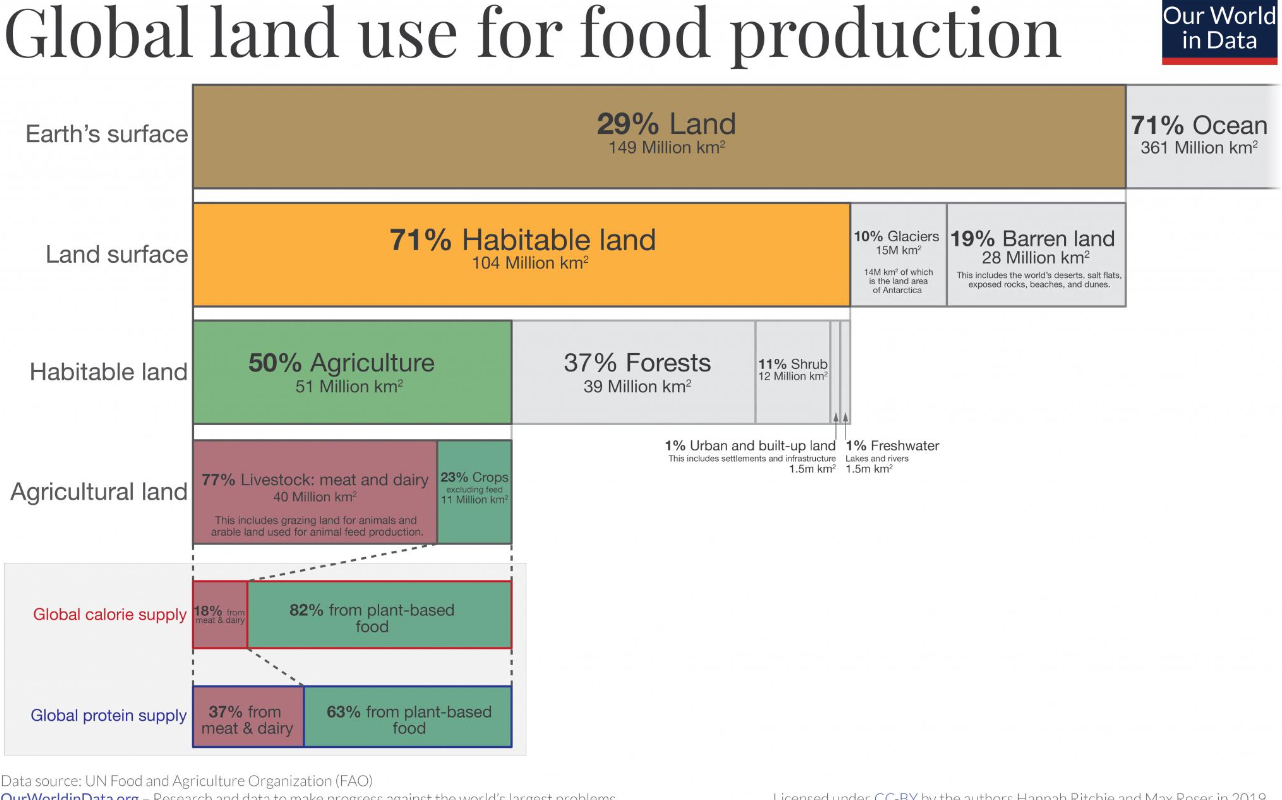
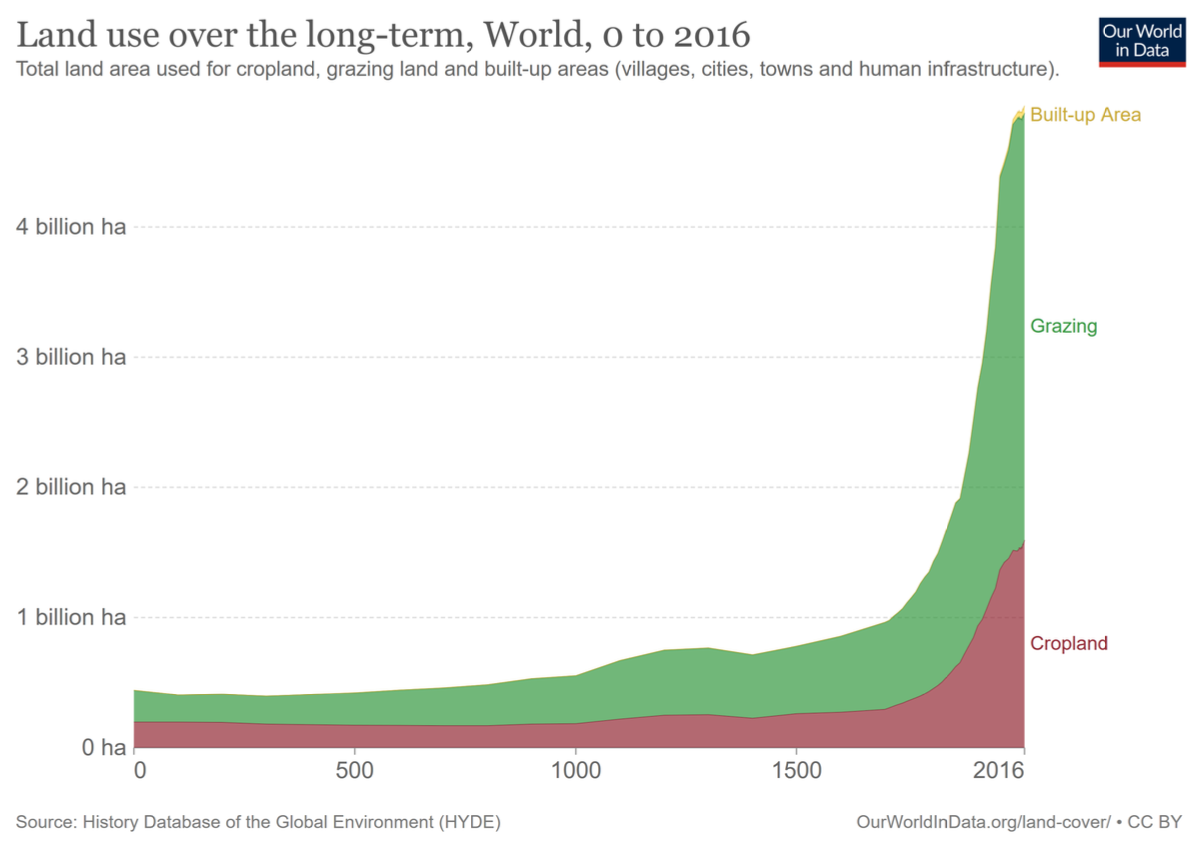
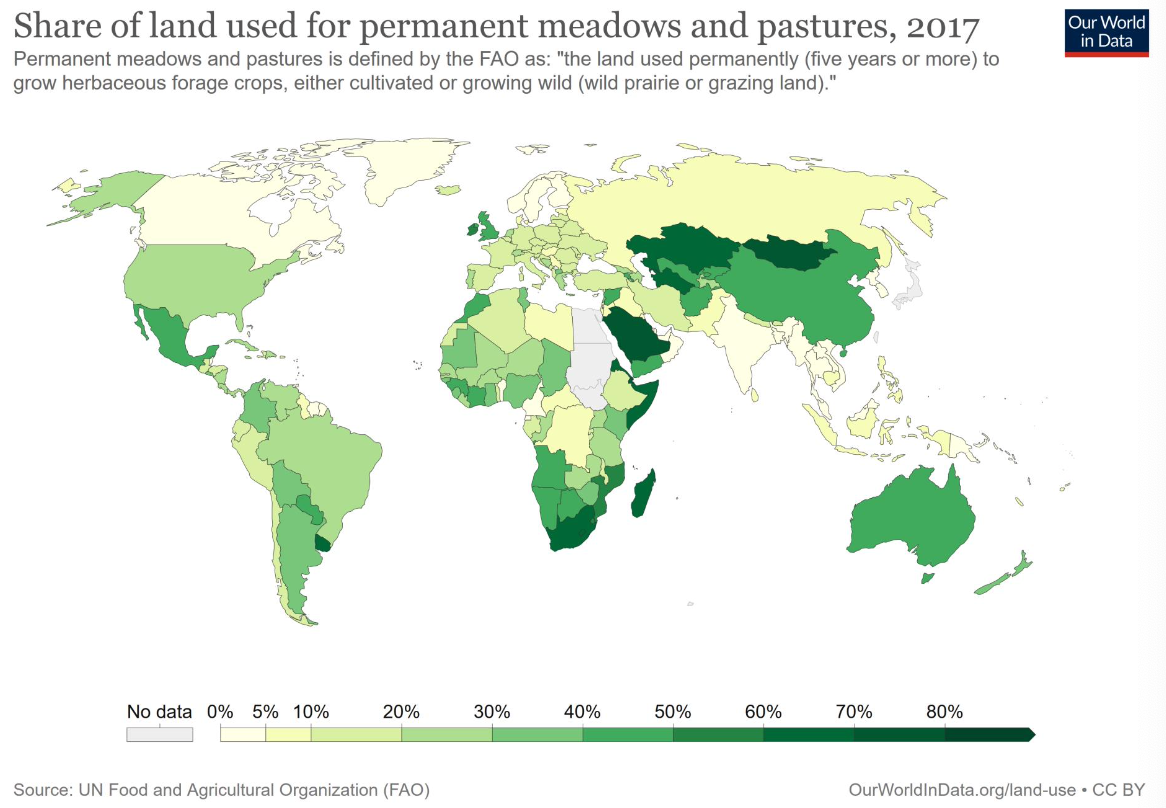
Grazing of animals is one of the most intense uses of land globally with obvious regional variability.
What is soil?
Regolith
Rhegos = blanket, lithos = stone
- Unconsolidated, heterogeneous layer of rocks, minerals, fragments of those, dust, sand, and soil (if present) that overlays bedrock
- Earth has many areas covered in regolith, of which soil is a dominant component
- Other examples: Beaches, glacial till, stream and riverbeds, volcanic ash
- Engineer’s view – more physical:
- ‘Soil is any un-cemented or weakly cemented accumulation of mineral particles formed by the weathering of rocks, [including] the void space between particles containing water and/or air.’ (Craig, 2001)
- Essentially, regolith…
- ‘Soil is any un-cemented or weakly cemented accumulation of mineral particles formed by the weathering of rocks, [including] the void space between particles containing water and/or air.’ (Craig, 2001)
- Soil scientist’s view – more chemical:
- ‘Soil is a combination of mineral and organic matter, water and air – that portion of the regolith that supports the growth of plants’
Soil and sediments are both formed by weathering processes, but…
- Sediment is transported and deposited in a new location
- Soil remains near where it was formed
Soil consists of mineral matter, air, water, and organic matter
- Soil organic matter (SOM)
- Living plants and animals
- Dead and decaying plants and animals
- Microorganisms
- SOM is lifeblood of soil – keeping it fertile
Weathering vs. Erosion
Erosion: the wearing away of soil and rock and the incorporation or transportation of material by a mobile agent, such as water, wind, or ice.
Weathering: essentially occurs in place; represents the preparation for erosion to take place.
Weathering is a continual process.
Soil is formed by weathering
- Weathering is the physical breakdown and chemical alteration of rocks (in situ– in place)
- Climate and water are major factors in weathering processes
- There are two main types of weathering:
- Mechanical Weathering: the physical breakdown of minerals and rocks by mechanical action. No chemical changes.
- Chemical Weathering: breakdown of rocks and minerals by chemical reactions, i.e., chemical alteration (decomposition and dissolution) of rock
Mechanical weathering
Mechanical Weathering
The physical breakdown of minerals and rocks by mechanical action. No chemical changes.
- Breaking materials down into smaller and smaller pieces
- Pieces retain the original characteristics of the parent material
- Total surface area and surface-to-volume ratio increases
Processes:
- Freeze-thaw cycle (ice/frost wedging)
- Salt wedging
- Expansion from unloading
- Thermal expansion
- Abrasion
- Biologic activity (roots, animals)
Chemical weathering
Chemical Weathering
Breakdown of rocks and minerals reactions (decomposition)
- Reactions with water, with chemicals dissolved in water, or with gases in the air
- Convert some or all of the parent material to different minerals
- Depends on minerals in the rock and condition in which the rock formed
Dissolution: Ions leached by water; e.g., halite (salt) or calcite

Hydrolysis: Hydrogen ion from water replaces cation in a mineral to form a new mineral; e.g., hydrolysis of K-feldspar to kaolinite (a clay)
Oxidation: Reaction with free oxygen in water or air; e.g., ferromagnesian silicates
Biological: Organisms produce compounds that react with, dissolve, or breakdown minerals; e.g., lichen (fungi and algae living together) – fungi releases chemicals to breakdown minerals that are used by algae
Rates of Weathering
- Climate impacts type of weathering and rates
- Water is an important weathering agent
- Heat increases reaction rates
- Chemical weathering may speed up mechanical weathering and vice versa
- Rocks that had minerals dissolved that were holding other grains together will be mechanically weathered easier
- Physical breakdown of rocks provides more surface area for chemical weathering
- Angular fragments weather faster than rounded ones
Soil Profiles
- Soil is made up of various layers or horizons, of different colour, composition, and physical properties.
- O horizon: only organic matter
- A horizon: most weathered mineral fragments mixed with organic matter
- E horizon/Zone of leaching: water and organic acids from above infiltrate and cause dissolution and transport (ie.e, leaching) of soluble minerals
- B horizon/Zone of accumulation: accumulation of leaching products (e.g., Fe & AI hydroxides, clays, some calcite)l no organic matter
- C horizon: broken up rock
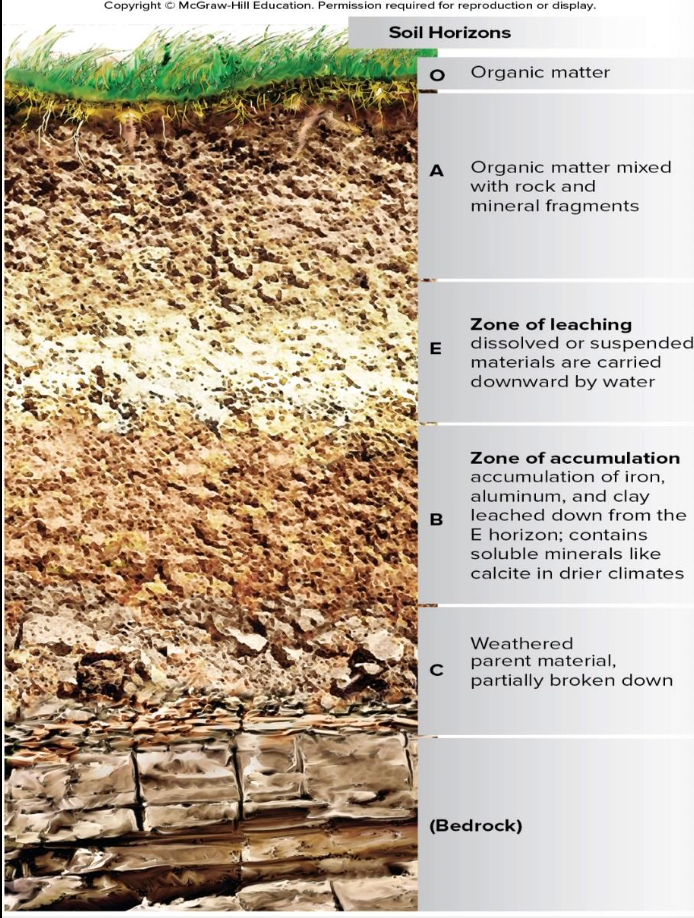
Soil Properties
Much of the chemical and physical properties of soil depends on the parent material.
Colour reflects compositional characteristics
- Dark more organic matter
- Light less organic matter
- Red or yellow iron

Soil Classification
Texture is related to the fragment sizes.
US Dept of Agriculture classification based on diameter:
- Clay < 0.002 mm
- Silt 0.05 - 0.002 mm
- Sand 0.05 - 2 mm
- Loam: mixture with all 3 components in similar proportions
Canadian soil texture triangle

-
HC = heavy clay
-
C = clay
-
S = sand
-
Si - silt
-
L = load
-
Texture influences soil drainage: important for farming and flooding.
- Drainage: sand > silt < clay.
-
Structure is based on the tendency to form lumps or clods called peds
-
Clumping inhibits erosion and can enhance ability to support plant growth, unless too large
-
Various sizes and shapes to peds
-
Classify soils according to similar composition or structure
-
Original scheme was based on composition, but it’s more for climate and generally how much leaching occurred



Humans and soils interact heavily... Mostly us causing problems.
Lateritic Soil
Laterite
Extreme pedalfer, formed in tropical climates with high temperatures and heavy rainfall severely leached
- No soluble nutrients remain for plant growth, even in forested areas
- Slash-and-burn agriculture does not work for long as laterite dries out quickly and becomes bricklike – resisting infiltration by water or plant roots
Wetland Soil
- Wetland soils are highly organic, low in oxygen, and soft
- Act as critical habitat for many species, as a trap for pollutants, and as flood control
- But are often drained for farmland or development

Soil Erosion
- Erosion is the transport of material elsewhere, typically by water or wind
- Rain can breakup/loosen soil, then surface runoff and/or wind carry it away
- Runoff erosion estimated via stream loads; Wind erosion harder to estimate

-
Dust Bowl (USA, 1930s) caused by clearing for wheat crops, over grazing, and other poor farming practices, then consecutive droughts and wind
-
Plowed deep; burned weeds; exposed over winter
-
Soil Conservation Service established to teach new farming practices, e.g., strip farming, crop rotation, trees to block wind
-
Sahel region (Africa)
- Overgrazing by cattle and goats is increasing with population explosion
- Desertification occuring
- Droughts increasingly more common
- Very windy region because of Sahara Desert
-
Northern and Western China
- ~28% of China is desert (78% of that is natural)
- Desertification area = half all farmland in Canada
-
100 million cows and ~300 million sheep and goats
- Wind and dust storms common
- Largest restoration effort in history: Great Green Wall – since 1978 planting 4500 km of trees to block wind; Also bringing water from the south

-
Impacts of soil erosion include:
- Loss of organic matter (horizon A), which is the best for farming (e.g., 6 inches of soil loss can lead to 40% reduction in crop yield)
- Transport of soil elsewhere may destroy or help the crops it lands on
- Need for more fertilizer is costly and results in less nutritious food
- Persistence of herbicides and pesticides because of loss of microorganisms to break them down
- Sediment pollution (physical and chemical) into rivers and streams reduces water quality, habitat, and causes infilling
-
Farming is the largest source of soil erosion, but other factors also cause it
- Strip mining
- Off-road vehicle use
- Construction (but short-lived)
‘Soil compaction, low organic matter, loss of soil structure, poor internal drainage, salinization, and soil acidity problems are other serious soil degradation conditions that can accelerate the soil erosion process.’
Soil Erosion vs. Formation?
- Looking at USA statistics:
- ~0.04 cm/year of soil is removed
- ~0.006 cm/year is formed
- 10x more lost than gained each year
- But very difficult to make these estimations, especially formation rates
- Some regions not forming any new soil (e.g., glacial bedrock in Canada)
Conclusion:
- Some agricultural practices are not sustainable
- Soil – and arable farmland - is not renewable in some regions
Reducing Soil Erosion
- Stabilize soil and reduce erosion
- Leave roots in ground after harvest then do not till
- Plant a ‘nurse crop’ in the off-season
- Reduce velocity of runoff
- Contour plowing– plow rows parallel to hill contours and perpendicular to direction of water flow
- Step or terrace farming – dividing a steeper slope into shallower steps or terraces
- Reduce velocity of wind
- Plant hedges or trees in rows around crops
- Fences also used to block wind
- Trip cropping – alternating crops of different heights
- Strop cropping + contour plowing to prevent water and wind erosion
- Some efforts are costly to implement and reduce crop yield
- If policies are enforced unevenly across a country, then some are put at a disadvantage
- The USA pays farmers to leave some highly erodible land clear for a certain amount of time, but that cost must outweigh what they can make by farming
- Efforts in USA have paid off

Other common-sense strategies:
- Restrict outdoor recreational vehicle use
- Construction projects in stages
- Stricter mining policies
Irrigation and Soil Chemistry
Irrigation runoff can redistribute soluble chemicals that become soluble

Soil Degradation is a Global Concern
Soil degradation includes:
- Desertification
- Erosion
- Deterioration of lateritic soil
- Pollution
- Other chemical modifications
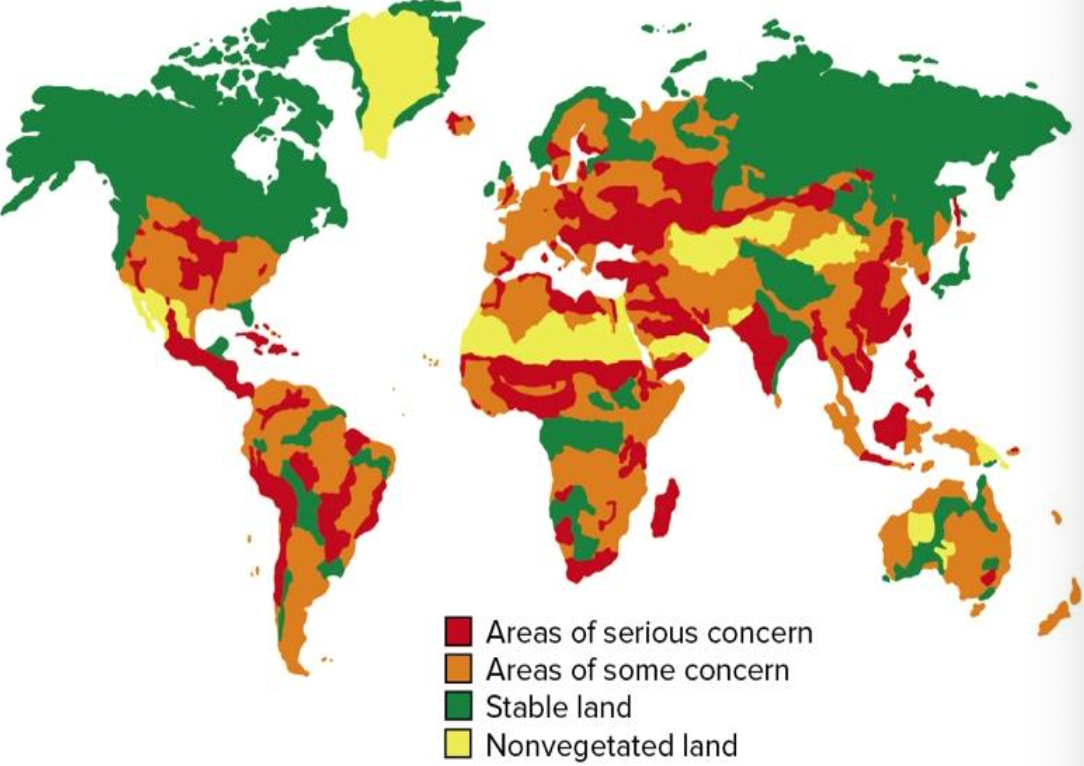
Causes vary regionally
- Deforestation
- Fuelwood overexploitation
- Overgrazing
- Agricultural practices
- Industrialization
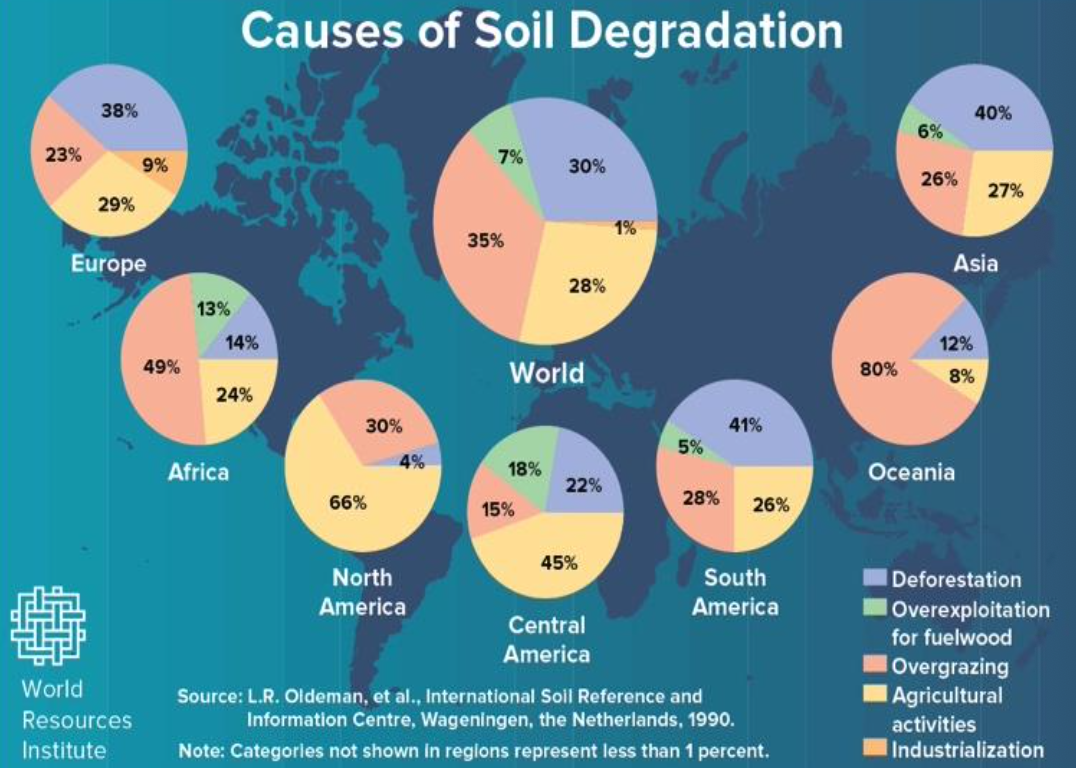
Share of land used for agriculture in 2018
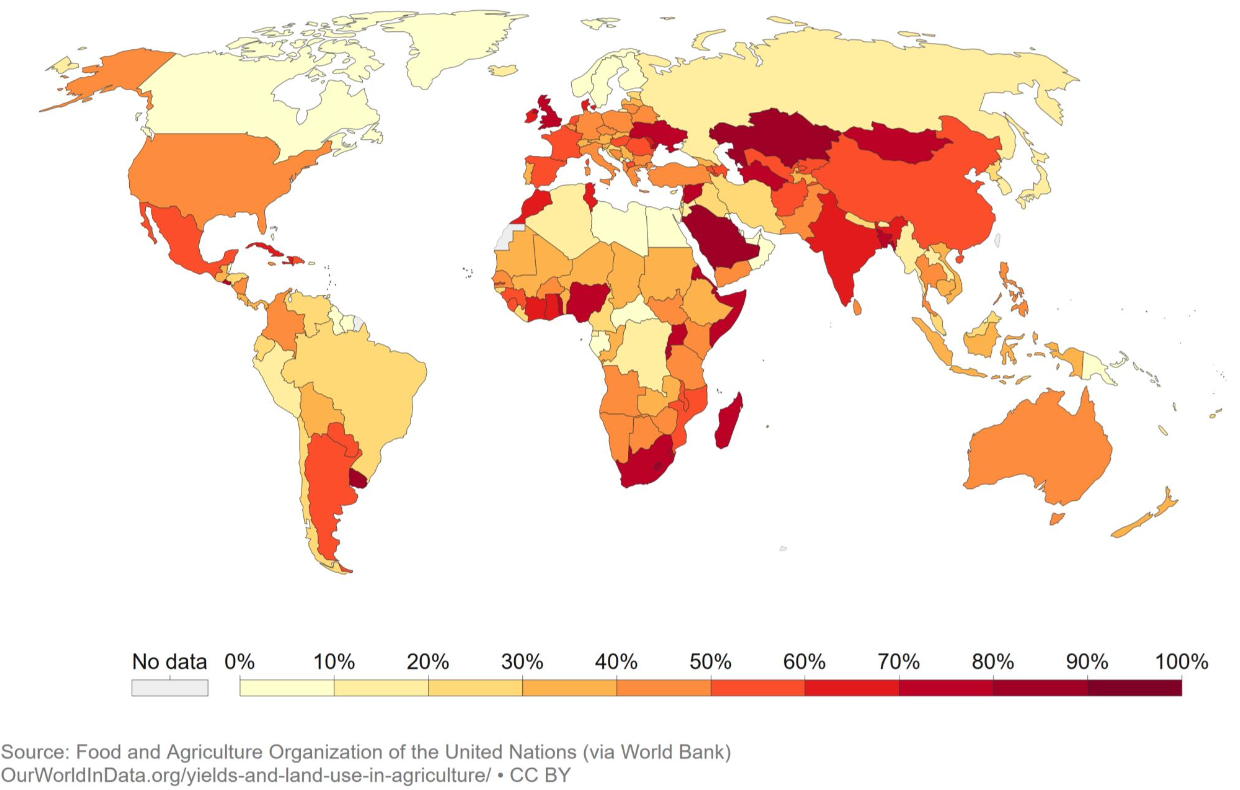
Grazing vs. Cropland
How do we reduce soil erosion caused by grazing?
- Laneways
- Lanes or laneways provide a controlled means to move animals from one section of a pasture to another or back and forth from the pasture to a barn
- Sacrifice Areas
- Sacrifice areas are those areas where animals are held for a period of time during inclement weather
- Streambank Fencing
- Streambank fencing is a means to improve water quality by establishing a vegetative buffer that captures nutrients before they enter a stream and prevents soil erosion
- Animal Movement
- When pastures are designed, care should be given to the expected animal movement across fields


